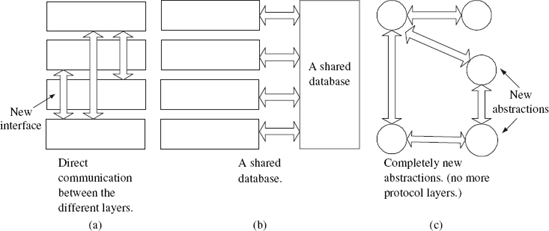6.5. Proposals for Implementing Cross-Layer Interactions
Alongside the cross-layer design proposals that we discussed in Section 6.4, initial proposals on how cross-layer interactions can be implemented are also being made in the literature. These can be put into three categories:
Direct communication between layers (Figure 6.2(a)).
A shared database across the layers (Figure 6.2(b)).
Completely new abstractions (Figure 6.2(c)).
Figure 6.2. Proposals for architectural blueprints

6.5.1. Direct Communication Between Layers
A straightforward way to allow run-time information sharing between the layers is to allow them to communicate with each other, as depicted schematically in Figure 6.2(a). Note that this is applicable when there has to be run-time information sharing between layers (for example, in cross-layer designs that rely on new interfaces or in dynamic vertical calibrations). Practically speaking direct communication between the layers means making the variables at one layer visible to the other layers at run-time. By contrast, under a strictly layered architecture, every layer manages its own variables and its variables are of no concern to other layers.
There are many ways in which the layers can communicate with one another. For instance, protocol headers may be used to allow flow of information between the layers. Alternatively, the extra 'inter-layer' information could ...
Get Cognitive Networks: Towards Self-Aware Networks now with the O’Reilly learning platform.
O’Reilly members experience books, live events, courses curated by job role, and more from O’Reilly and nearly 200 top publishers.

